The Complex Valorization of Black Alder Bark Biomass in Compositions of Rigid Polyurethane Foam
Abstract
1. Introduction
2. Materials and Methods
2.1. Materials for Synthesis of Bio-Polyols and PUR Foams
2.2. Characterization of BA Bark Biomass
2.3. Synthesis of Bio-Polyols
2.3.1. The Liquefaction of BA Bark Extractives
2.3.2. Oxypropylation of BA Bark Extractives with PC
2.4. Characterization of Bio-Polyols
2.5. PUR Foam Preparation
- MpMDI—weight of pMDI (g);
- M1OH—weight of polyol 1(g);
- M2OH—weight of polyol 2 (g);
- MH2O—weight of water in system (g);
- 18—molar weight of water (g∙mol−1);
- EW1—equivalent weight of polyol 1 (g∙Eq−1);
- EW1—equivalent weight of polyol 2 (g∙Eq−1);
- 133.3—equivalent weight of pMDI (g∙Eq−1);
- 1.15—molar NCO/OH ratio.
2.6. Characterization of PUR Foams
2.7. Pretreatment of Extracted BA Bark for Use as a Filler in the PUR Foam Compositions
2.8. Filler Characterization
3. Results and Discussion
3.1. The Characteristics of BA Bark Biomass
3.2. Liquefaction of BA Bark Extractives
3.2.1. The Yield of Liquefaction and Dependence on Processing Conditions
- Mn—number average molecular weight, g∙mol−1;
- f—the number of OH groups per mol, equal 3;
- 56,100—equivalent weight of KOH, mg∙Eq−1;
- OHV—hydroxyl value of Lupranol 3300, equal to 400 mgKOH·g−1.
3.2.2. The Characteristics of Bio-Polyols Generated via Liquefaction of BA Bark Extractives in Lupranol 3300
3.3. The “Green” Oxypropylation of BA Bark Extractives with PC and Characteristics of Ensuing Polyols
3.4. Characteristic of Extracted BA Bark and Its Pretreatment for Utilization as a Natural Filler in Rigid PUR Foam Compositions
Proximate and TG/DTG Analysis
3.5. Rigid PUR Foams Based on BA Bark Extractive-Derived Polyols
3.5.1. Compositions of PUR Foams
3.5.2. Dynamics of PUR Foam Rising
3.5.3. Structural Characterization of PUR Foams via FTIR
3.5.4. Apparent Density and Compression Properties of Rigid PUR Foams
- σnorm, Enorm—normalized compression strength and Young’s modulus, respectively (MPa);
- σexp, Eexp—experimental compression strength and Young’s modulus, respectively (MPa);
- exp—experimental apparent density (kg m−3).
3.5.5. The Morphological Structure of PUR Foams
3.5.6. Thermal Degradation of PUR Foams in Air
4. Conclusions
Supplementary Materials
Author Contributions
Funding
Institutional Review Board Statement
Informed Consent Statement
Data Availability Statement
Acknowledgments
Conflicts of Interest
References
- Grand View Research. Polyurethane Foam Market Size, Share & Trends Analysis Report by Product (Rigid Foam, Flexible Foam), By Application (Bedding & Furniture, Transportation, Packaging, Construction, Electronics, Footwear), by Region, and Segment Forecasts, 2024–2030. Available online: https://www.grandviewresearch.com/industry-analysis/polyurethane-foam-market (accessed on 13 November 2024).
- Vieira, F.R.; Magina, S.; Evtuguin, D.V.; Barros-Timmons, A. Lignin as a Renewable Building Block for Sustainable Polyurethanes. Materials 2022, 15, 6182. [Google Scholar] [CrossRef]
- Amran, U.A.; Salleh, K.M.; Zakaria, S.; Roslan, R.; Chia, C.H.; Jaafar, S.N.S.; Sajab, M.S.; Mostapha, M. Production of Rigid Polyurethane Foams Using Polyol from Liquefied Oil Palm Biomass: Variation of Isocyanate Indexes. Polymers 2021, 13, 3072. [Google Scholar] [CrossRef] [PubMed]
- Hirvonen, J.; Jokisalo, J.; Heljo, J.; Kosonen, R. Towards the EU Emission Targets of 2050: Cost-Effective Emission Reduction in Finnish Detached Houses. Energies 2019, 12, 4395. [Google Scholar] [CrossRef]
- Mordor Intelligence. Methylene Diphenyl Di-Isocyanate (MDI) Market Size. Available online: https://www.mordorintelligence.com/industry-reports/methylene-diphenyl-di-isocyanate-mdi-market (accessed on 13 November 2024).
- Kreye, O.; Mutlu, H.; Meier, M.A.R. Sustainable Routes to Polyurethane Precursors. Green Chem. 2013, 15, 1431. [Google Scholar] [CrossRef]
- Rubens, M.; Van Wesemael, M.; Feghali, E.; Lufungula, L.L.; Blockhuys, F.; Vanbroekhoven, K.; Eevers, W.; Vendamme, R. Exploring the Reactivity of Aliphatic and Phenolic Hydroxyl Groups in Lignin Hydrogenolysis Oil towards Urethane Bond Formation. Ind. Crops Prod. 2022, 180, 114703. [Google Scholar] [CrossRef]
- Kaikade, D.S.; Sabnis, A.S. Polyurethane Foams from Vegetable Oil-Based Polyols: A Review. Polym. Bull. 2023, 80, 2239–2261. [Google Scholar] [CrossRef]
- Lavazza, J.; Zhang, Q.; de Kergariou, C.; Comandini, G.; Briscoe, W.H.; Rowlandson, J.L.; Panzera, T.H.; Scarpa, F. Rigid Polyurethane Foams from Commercial Castor Oil Resins. Polym. Test 2024, 135, 108457. [Google Scholar] [CrossRef]
- Tan, S.; Abraham, T.; Ference, D.; Macosko, C.W. Rigid Polyurethane Foams from a Soybean Oil-Based Polyol. Polymer 2011, 52, 2840–2846. [Google Scholar] [CrossRef]
- Członka, S.; Bertino, M.F.; Kośny, J.; Strąkowska, A.; Masłowski, M.; Strzelec, K. Linseed Oil as a Natural Modifier of Rigid Polyurethane Foams. Ind. Crops Prod. 2018, 115, 40–51. [Google Scholar] [CrossRef]
- Coman, A.E.; Peyrton, J.; Hubca, G.; Sarbu, A.; Gabor, A.R.; Nicolae, C.A.; Iordache, T.V.; Averous, L. Synthesis and Characterization of Renewable Polyurethane Foams Using Different Biobased Polyols from Olive Oil. Eur. Polym. J. 2021, 149, 110363. [Google Scholar] [CrossRef]
- Kirpluks, M.; Kalnbunde, D.; Walterova, Z.; Cabulis, U. Rapeseed Oil as Feedstock for High Functionality Polyol Synthesis. J. Renew. Mater. 2017, 5, 258–270. [Google Scholar] [CrossRef]
- Asare, M.A.; Kote, P.; Chaudhary, S.; de Souza, F.M.; Gupta, R.K. Sunflower Oil as a Renewable Resource for Polyurethane Foams: Effects of Flame-Retardants. Polymers 2022, 14, 5282. [Google Scholar] [CrossRef] [PubMed]
- Valero, M.F.; Gonzalez, A. Polyurethane Adhesive System from Castor Oil Modified by a Transesterification Reaction. J. Elastomers Plast. 2012, 44, 433–442. [Google Scholar] [CrossRef]
- Malewska, E.; Polaczek, K.; Kurańska, M. Impact of Various Catalysts on Transesterification of Used Cooking Oil and Foaming Processes of Polyurethane Systems. Materials 2022, 15, 7807. [Google Scholar] [CrossRef]
- Yakushin, V.; Misane, M.; Bikovens, O.; Vilsone, D.; Sevastyanova, I. Synthesis of Trimethylolpropane Esters of Tall Oil Fatty Acids and Properties of Polyurethane Coatings on Their Basis. J. Coat. Technol. Res. 2016, 13, 317–324. [Google Scholar] [CrossRef]
- Kauliņa, E.; Abolins, A.; Fridrihsone, A.; Kirpluks, M. Potential of Crude Tall Oil Polyols for Rigid Polyurethane Foam Production and Their Comparison with Tall Oil Fatty Acids Polyols. Mater. Sci. Forum 2022, 1071, 174–181. [Google Scholar] [CrossRef]
- Kirpluks, M.; Vanags, E.; Abolins, A.; Michalowski, S.; Fridrihsone, A.; Cabulis, U. High Functionality Bio-Polyols from Tall Oil and Rigid Polyurethane Foams Formulated Solely Using Bio-Polyols. Materials 2020, 13, 1985. [Google Scholar] [CrossRef]
- Phung Hai, T.A.; Tessman, M.; Neelakantan, N.; Samoylov, A.A.; Ito, Y.; Rajput, B.S.; Pourahmady, N.; Burkart, M.D. Renewable Polyurethanes from Sustainable Biological Precursors. Biomacromolecules 2021, 22, 1770–1794. [Google Scholar] [CrossRef] [PubMed]
- Członka, S.; Strąkowska, A.; Kairytė, A. Application of Walnut Shells-Derived Biopolyol in the Synthesis of Rigid Polyurethane Foams. Materials 2020, 13, 2687. [Google Scholar] [CrossRef]
- Bontaş, M.G.; Diacon, A.; Călinescu, I.; Rusen, E. Lignocellulose Biomass Liquefaction: Process and Applications Development as Polyurethane Foams. Polymers 2023, 15, 563. [Google Scholar] [CrossRef]
- Oliveira, W.D.; Glasser, W.G. Engineering Plastics from Lignin. XVI. Starlike Macromers with Propylene Oxide. J. Appl. Polym. Sci. 1989, 37, 3119–3135. [Google Scholar] [CrossRef]
- Kelley, S.S.; Glasser, W.G.; Ward, T.C. Engineering Plastics from Lignin XIV. Characterization of Chain-Extended Hydroxypropyl Lignins. J. Wood Chem. Technol. 1988, 8, 341–359. [Google Scholar] [CrossRef]
- Mahmood, N.; Yuan, Z.; Schmidt, J.; Xu, C. Depolymerization of Lignins and Their Applications for the Preparation of Polyols and Rigid Polyurethane Foams: A Review. Renew. Sustain. Energy Rev. 2016, 60, 317–329. [Google Scholar] [CrossRef]
- D’Souza, J.; George, B.; Camargo, R.; Yan, N. Synthesis and Characterization of Bio-Polyols through the Oxypropylation of Bark and Alkaline Extracts of Bark. Ind. Crops Prod. 2015, 76, 1–11. [Google Scholar] [CrossRef]
- Evtiouguina, M.; Barros-Timmons, A.; Cruz-Pinto, J.J.; Neto, C.P.; Belgacem, M.N.; Gandini, A. Oxypropylation of Cork and the Use of the Ensuing Polyols in Polyurethane Formulations. Biomacromolecules 2002, 3, 57–62. [Google Scholar] [CrossRef] [PubMed]
- Serrano, L.; Alriols, M.G.; Briones, R.; Mondragón, I.; Labidi, J. Oxypropylation of Rapeseed Cake Residue Generated in the Biodiesel Production Process. Ind. Eng. Chem. Res. 2010, 49, 1526–1529. [Google Scholar] [CrossRef]
- Pavier, C.; Gandini, A. Oxypropylation of Sugar Beet Pulp. Ind. Crops Prod. 2000, 12, 1–8. [Google Scholar] [CrossRef]
- Gandini, A.; Belgacem, M.N. Partial or Total Oxypropylation of Natural Polymers and the Use of the Ensuing Materials as Composites or Polyol Macromonomers. In Monomers, Polymers and Composites from Renewable Resources; Elsevier: Amsterdam, The Netherlands, 2008; pp. 273–288. [Google Scholar]
- Vieira, F.R.; Gama, N.V.; Evtuguin, D.V.; Amorim, C.O.; Amaral, V.S.; Pinto, P.C.O.R.; Barros-Timmons, A. Bio-Based Polyurethane Foams from Kraft Lignin with Improved Fire Resistance. Polymers 2023, 15, 1074. [Google Scholar] [CrossRef] [PubMed]
- Kühnel, I.; Saake, B.; Lehnen, R. Comparison of Different Cyclic Organic Carbonates in the Oxyalkylation of Various Types of Lignin. React. Funct. Polym. 2017, 120, 83–91. [Google Scholar] [CrossRef]
- Arshanitsa, A.; Pals, M.; Godina, D.; Bikovens, O. The Oxyalkylation of Hydrophilic Black Alder Bark Extractives with Propylene Carbonate with a Focus on Green Polyols Synthesis. J. Renew. Mater. 2024, 12, 1927–1948. [Google Scholar] [CrossRef]
- Yip, J.; Chen, M.; Szeto, Y.S.; Yan, S. Comparative Study of Liquefaction Process and Liquefied Products from Bamboo Using Different Organic Solvents. Bioresour. Technol. 2009, 100, 6674–6678. [Google Scholar] [CrossRef] [PubMed]
- Serrano, L.; Rincón, E.; García, A.; Rodríguez, J.; Briones, R. Bio-Degradable Polyurethane Foams Produced by Liquefied Polyol from Wheat Straw Biomass. Polymers 2020, 12, 2646. [Google Scholar] [CrossRef]
- Jin, Y.; Ruan, X.; Cheng, X.; Lü, Q. Liquefaction of Lignin by Polyethyleneglycol and Glycerol. Bioresour. Technol. 2011, 102, 3581–3583. [Google Scholar] [CrossRef] [PubMed]
- D’Souza, J.; Camargo, R.; Yan, N. Polyurethane Foams Made from Liquefied Bark-based Polyols. J. Appl. Polym. Sci. 2014, 131, 16. [Google Scholar] [CrossRef]
- D’Souza, J.; Wong, S.Z.; Camargo, R.; Yan, N. Solvolytic Liquefaction of Bark: Understanding the Role of Polyhydric Alcohols and Organic Solvents on Polyol Characteristics. ACS Sustain. Chem. Eng. 2016, 4, 851–861. [Google Scholar] [CrossRef]
- Cinelli, P.; Anguillesi, I.; Lazzeri, A. Green Synthesis of Flexible Polyurethane Foams from Liquefied Lignin. Eur. Polym. J. 2013, 49, 1174–1184. [Google Scholar] [CrossRef]
- Zhang, J.; Du, M.; Hu, L. Factors Influencing Polyol Liquefaction of Nut Shells of Different Camellia Species. Bioresources 2016, 11, 9956–9969. [Google Scholar] [CrossRef][Green Version]
- Pásztory, Z.; Mohácsiné, I.R.; Gorbacheva, G.; Börcsök, Z. The Utilization of Tree Bark. Bioresources 2016, 11, 7859–7888. [Google Scholar] [CrossRef]
- Jeżo, A.; Wronka, A.; Dębiński, A.; Kristak, L.; Reh, R.; Rizhikovs, J.; Kowaluk, G. Influence of Upcycled Post-Treatment Bark Biomass Addition to the Binder on Produced Plywood Properties. Forests 2023, 14, 110. [Google Scholar] [CrossRef]
- Salca, E.-A. Black Alder (Alnus Glutinosa L.)—A Resource for Value-Added Products in Furniture Industry Under European Screening. Curr. For. Rep. 2019, 5, 41–54. [Google Scholar] [CrossRef]
- Arshanitsa, A.; Ponomarenko, J.; Lauberte, L.; Jurkjane, V.; Pals, M.; Akishin, Y.; Lauberts, M.; Jashina, L.; Bikovens, O.; Telysheva, G. Advantages of MW-Assisted Water Extraction, Combined with Steam Explosion, of Black Alder Bark in Terms of Isolating Valuable Compounds and Energy Efficiency. Ind. Crops Prod. 2022, 181, 114832. [Google Scholar] [CrossRef]
- Pals, M.; Lauberte, L.; Ponomarenko, J.; Lauberts, M.; Arshanitsa, A. Microwave-Assisted Water Extraction of Aspen (Populus Tremula) and Pine (Pinus sylvestris L.) Barks as a Tool for Their Valorization. Plants 2022, 11, 1544. [Google Scholar] [CrossRef]
- Argyropoulos, D. Quantitative Phosphorus-31 NMR Analysis of Lignins, a New Tool for the Lignin Chemist. J. Wood Chem. Technol. 1994, 14, 45–63. [Google Scholar] [CrossRef]
- Argyropoulos, D.S.; Pajer, N.; Crestini, C. Quantitative 31P NMR Analysis of Lignins and Tannins. J. Vis. Exp. 2021, 174, e62696. [Google Scholar] [CrossRef]
- Gosz, K.; Kowalkowska-Zedler, D.; Haponiuk, J.; Piszczyk, Ł. Liquefaction of Alder Wood as the Source of Renewable and Sustainable Polyols for Preparation of Polyurethane Resins. Wood Sci. Technol. 2020, 54, 103–121. [Google Scholar] [CrossRef]
- Zakis, G.F. Functional Analysis of Lignins and Their Derivatives; TAPPI Press: Atlanta, GA, USA, 1994; ISBN 0898522587. [Google Scholar]
- Ionescu, M. Chemistry and Technology of Polyols for Polyurethanes; Rapra Technology: Shawbury, UK, 2005; Volume 1, ISBN 9781910242131. [Google Scholar]
- Olszewski, A.; Kosmela, P.; Vēvere, L.; Kirpluks, M.; Cabulis, U.; Piszczyk, Ł. Effect of Bio-Polyol Molecular Weight on the Structure and Properties of Polyurethane-Polyisocyanurate (PUR-PIR) Foams. Sci. Rep. 2024, 14, 812. [Google Scholar] [CrossRef]
- Arshanitsa, A.; Ponomarenko, J.; Pals, M.; Jashina, L. Controlling the Reactivity of Hydrophilic Bark Extractives as Biopolyols in Urethane-Formation Reactions Using Various Catalysts. Ind. Crops Prod. 2023, 204, 117385. [Google Scholar] [CrossRef]
- Arshanitsa, A.; Ponomarenko, J.; Pals, M.; Jashina, L.; Lauberts, M. Impact of Bark-Sourced Building Blocks as Substitutes for Fossil-Derived Polyols on the Structural, Thermal, and Mechanical Properties of Polyurethane Networks. Polymers 2023, 15, 3503. [Google Scholar] [CrossRef]
- Alma, M.H.; Shiraishi, N. Preparation of Polyurethane-like Foams from NaOH-Catalyzed Liquefied Wood. Holz Roh-Und Werkst. 1998, 56, 245–246. [Google Scholar] [CrossRef]
- Robyt, J.F. Essentials of Carbohydrate Chemistry; Springer: New York, NY, USA, 1998; ISBN 978-1-4612-7220-5. [Google Scholar]
- Zhang, Z.; Huber, G.W. Catalytic Oxidation of Carbohydrates into Organic Acids and Furan Chemicals. Chem. Soc. Rev. 2018, 47, 1351–1390. [Google Scholar] [CrossRef] [PubMed]
- Hellwig, P. Infrared Spectroscopic Markers of Quinones in Proteins from the Respiratory Chain. Biochim. Biophys. Acta (BBA) Bioenerg. 2015, 1847, 126–133. [Google Scholar] [CrossRef]
- Kutyrev, A.A. Nucleophilic Reactions of Quinones. Tetrahedron 1991, 47, 8043–8065. [Google Scholar] [CrossRef]
- Saunders, J.H.; Frisch, K.C. Polyurethanes: Chemistry and Technology; High polymers—A Series of Monographs on the Chemistry, Physics and Technology of High Polymeric Substances; Interscience Publishers: New York, NY, USA, 1962. [Google Scholar]
- Dulyanska, Y.; Cruz-Lopes, L.; Esteves, B.; Guiné, R.; Domingos, I. FTIR Monitoring of Polyurethane Foams Derived from Acid-Liquefied and Base-Liquefied Polyols. Polymers 2024, 16, 2214. [Google Scholar] [CrossRef] [PubMed]
- Sheridan, J.E.; Haines, C.A. Qualitative and Quantitative Analyses of Isocyanurate-Containing Foams by Thermal Techniques. J. Cell. Plast. 1971, 7, 135–139. [Google Scholar] [CrossRef]
- Reignier, J.; Méchin, F.; Sarbu, A. Chemical Gradients in PIR Foams as Probed by ATR-FTIR Analysis and Consequences on Fire Resistance. Polym. Test 2021, 93, 106972. [Google Scholar] [CrossRef]
- Ivdre, A.; Abolins, A.; Volkovs, N.; Vevere, L.; Paze, A.; Makars, R.; Godina, D.; Rizikovs, J. Rigid Polyurethane Foams as Thermal Insulation Material from Novel Suberinic Acid-Based Polyols. Polymers 2023, 15, 3124. [Google Scholar] [CrossRef]
- Park, D.H.; Park, G.P.; Kim, S.H.; Kim, W.N. Effects of Isocyanate Index and Environmentally-Friendly Blowing Agents on the Morphological, Mechanical, and Thermal Insulating Properties of Polyisocyanurate-Polyurethane Foams. Macromol. Res. 2013, 21, 852–859. [Google Scholar] [CrossRef]
- Hawkins, M.C.; O’Toole, B.; Jackovich, D. Cell Morphology and Mechanical Properties of Rigid Polyurethane Foam. J. Cell. Plast. 2005, 41, 267–285. [Google Scholar] [CrossRef]
- Shivakumar, N.D.; Deb, A. Dependence of the Mechanical Properties of Rigid PU Foam on Density. J. Reinf. Plast. Compos. 2022, 41, 355–363. [Google Scholar] [CrossRef]
- Sture, B.; Vevere, L.; Kirpluks, M.; Godina, D.; Fridrihsone, A.; Cabulis, U. Polyurethane Foam Composites Reinforced with Renewable Fillers for Cryogenic Insulation. Polymers 2021, 13, 4089. [Google Scholar] [CrossRef]
- Husainie, S.M.; Deng, X.; Ghalia, M.A.; Robinson, J.; Naguib, H.E. Natural Fillers as Reinforcement for Closed-Molded Polyurethane Foam Plaques: Mechanical, Morphological, and Thermal Properties. Mater. Today Commun. 2021, 27, 102187. [Google Scholar] [CrossRef]
- Soloveva, O.V.; Solovev, S.A.; Vankov, Y.V.; Shakurova, R.Z. Experimental Studies of the Effective Thermal Conductivity of Polyurethane Foams with Different Morphologies. Processes 2022, 10, 2257. [Google Scholar] [CrossRef]
- Glicksman, L.; Stewart, J. The Measurement of the Morphology of Closed Cell Foams Which Control the Overall Thermal Conductivity. In Insulation Materials: Testing and Applications; ASTM International: West Conshohocken, PA, USA, 1997; Volume 3, pp. 307–334. [Google Scholar]
- Lemmon, E.W.; Jacobsen, R.T. Viscosity and Thermal Conductivity Equations for Nitrogen, Oxygen, Argon, and Air. Int. J. Thermophys. 2004, 25, 21–69. [Google Scholar] [CrossRef]
- Chattopadhyay, D.K.; Webster, D.C. Thermal Stability and Flame Retardancy of Polyurethanes. Prog. Polym. Sci. 2009, 34, 1068–1133. [Google Scholar] [CrossRef]
- Jiao, L.; Xiao, H.; Wang, Q.; Sun, J. Thermal Degradation Characteristics of Rigid Polyurethane Foam and the Volatile Products Analysis with TG-FTIR-MS. Polym. Degrad. Stab. 2013, 98, 2687–2696. [Google Scholar] [CrossRef]
- Gupta, T.; Adhikari, B. Thermal Degradation and Stability of HTPB-Based Polyurethane and Polyurethaneureas. Thermochim. Acta 2003, 402, 169–181. [Google Scholar] [CrossRef]
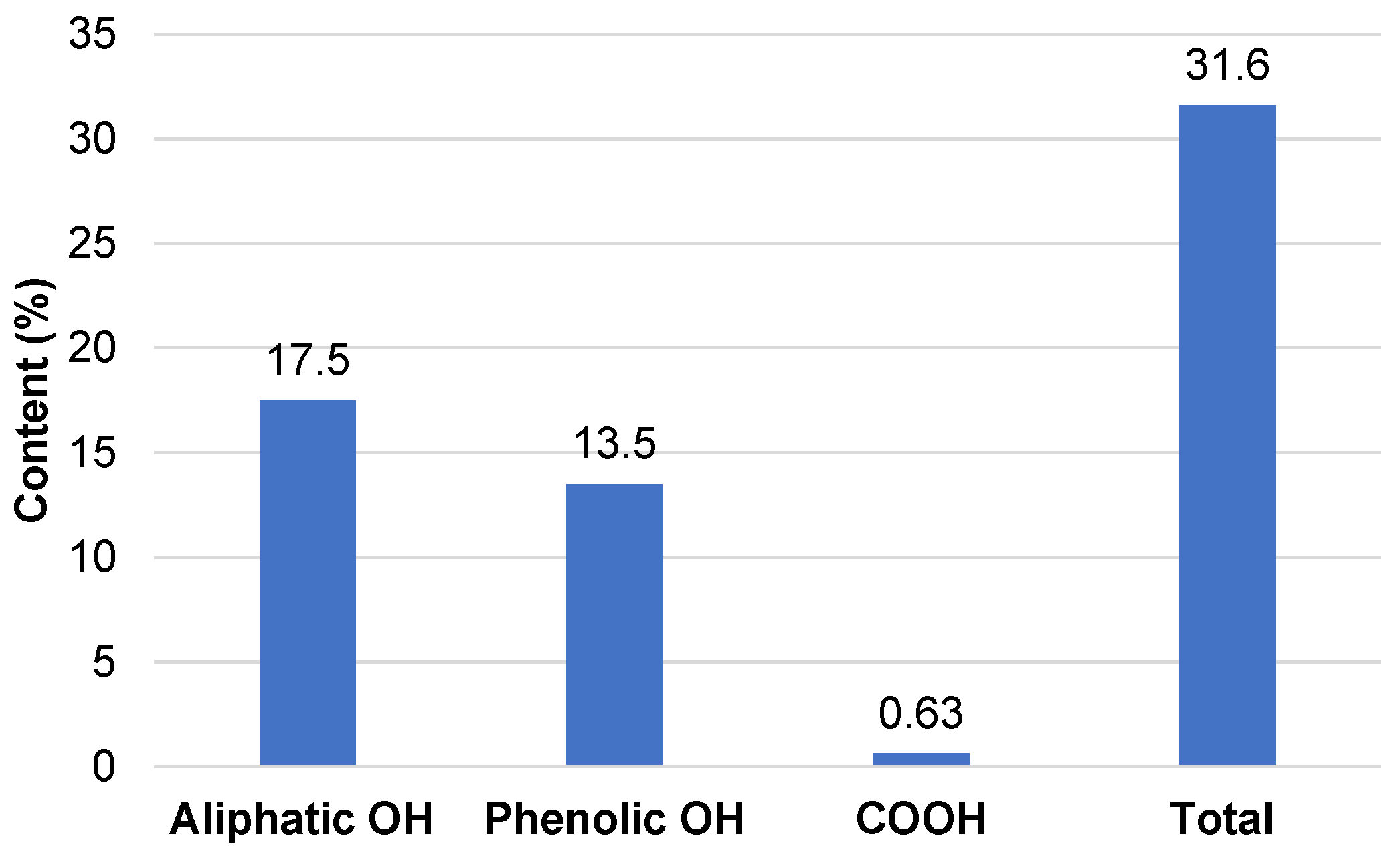
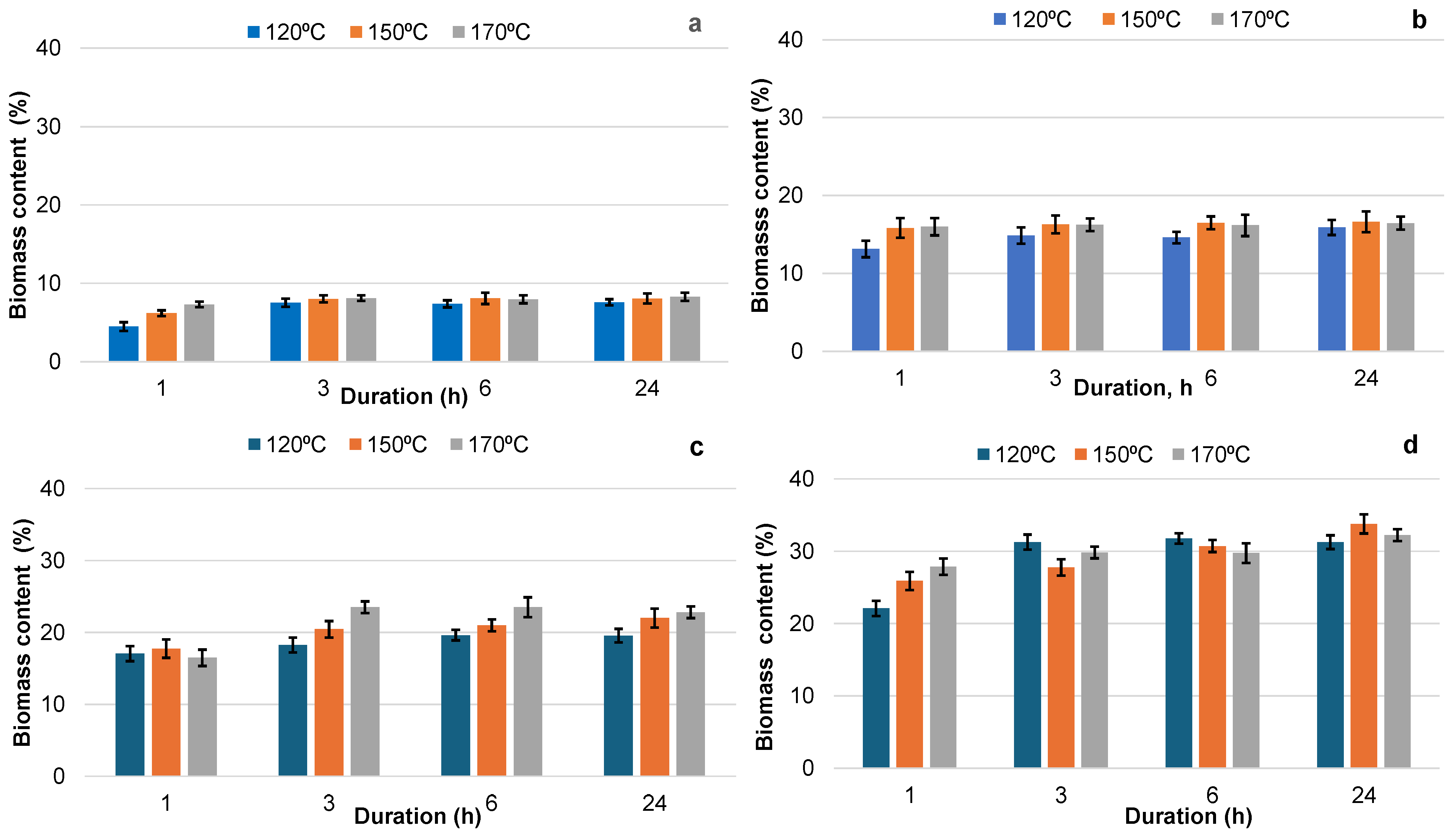




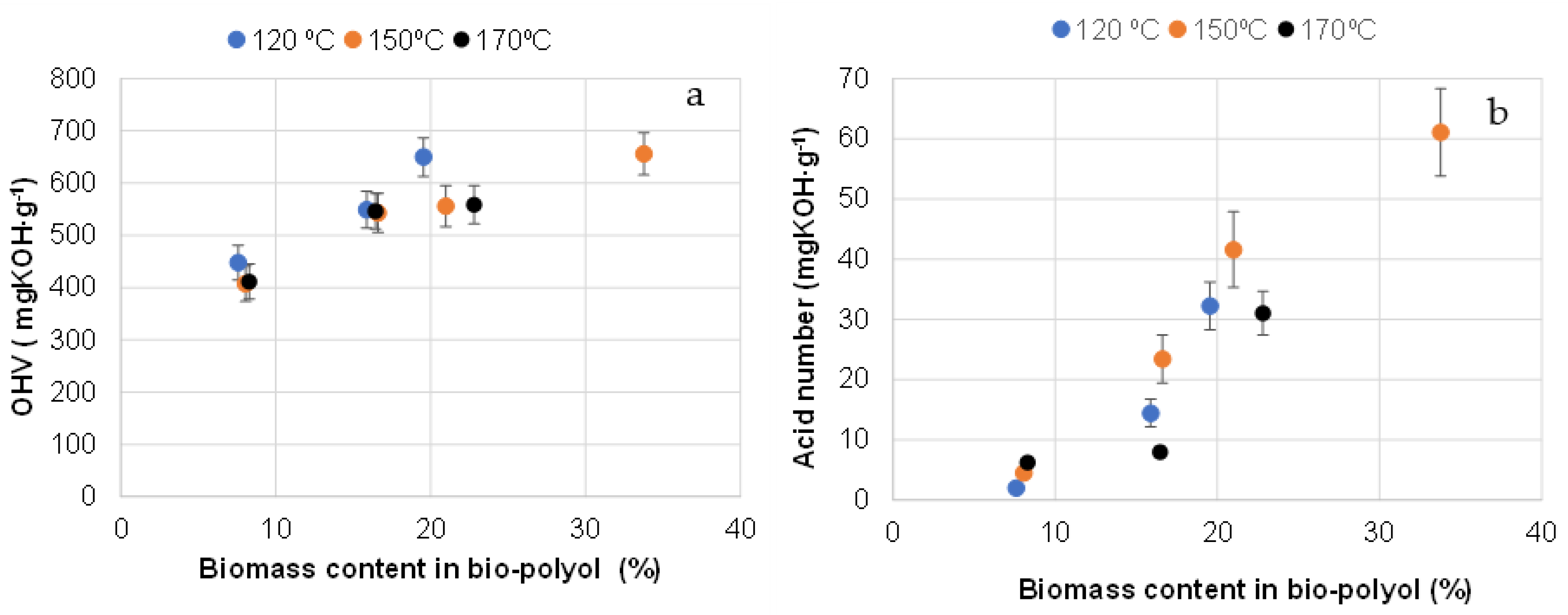
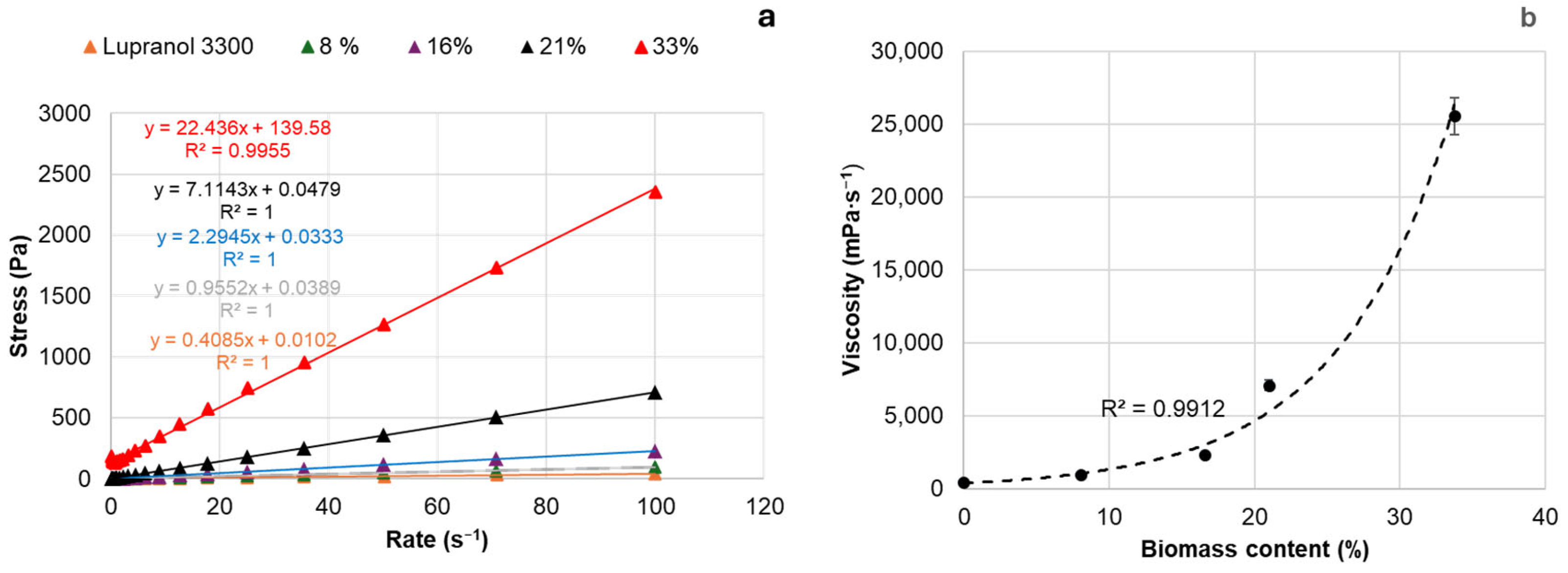

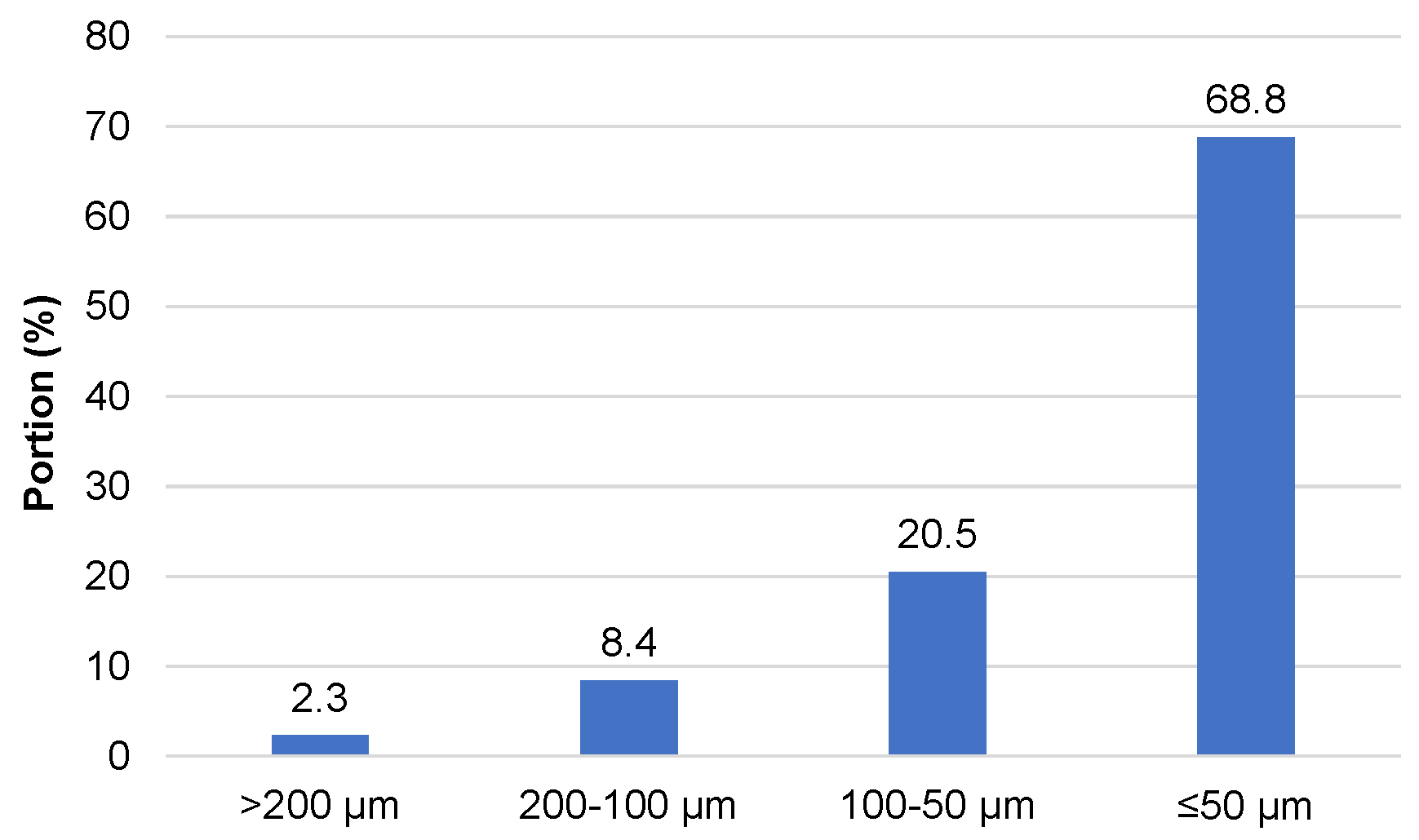
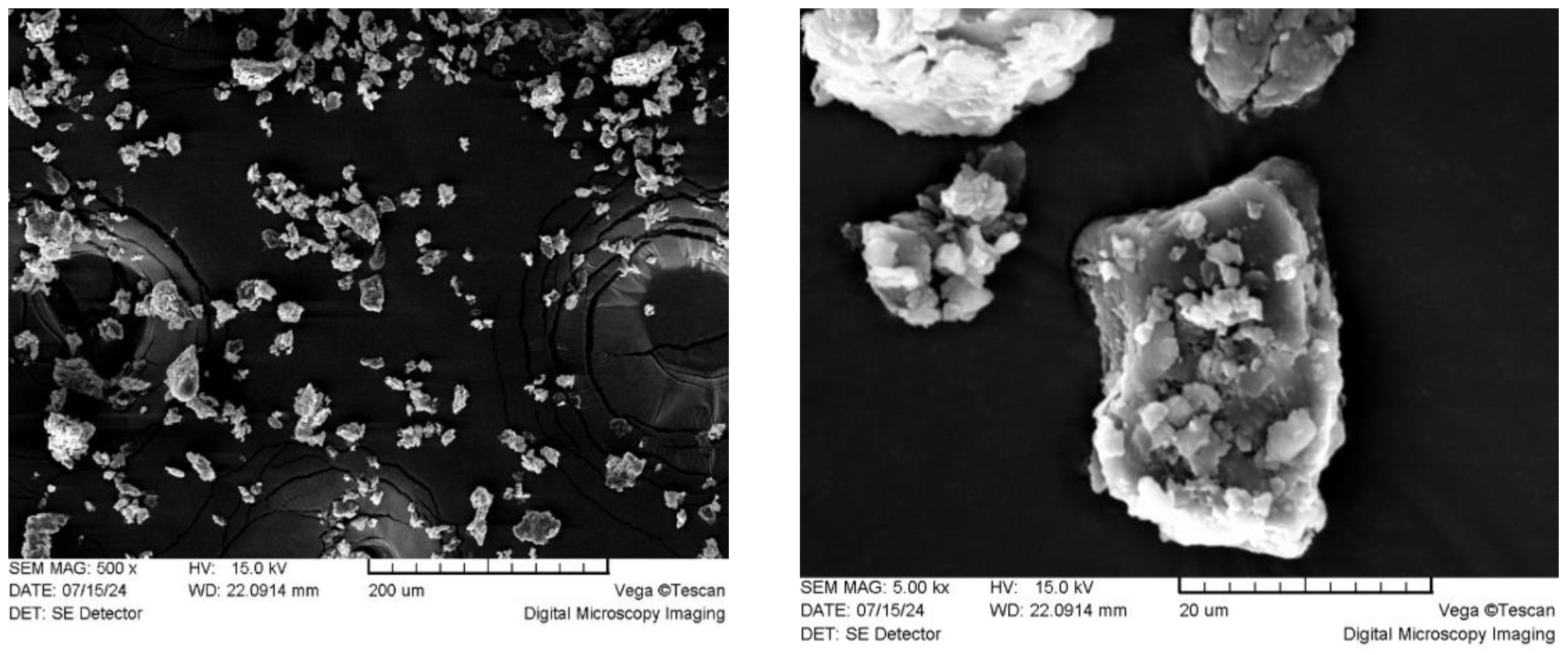


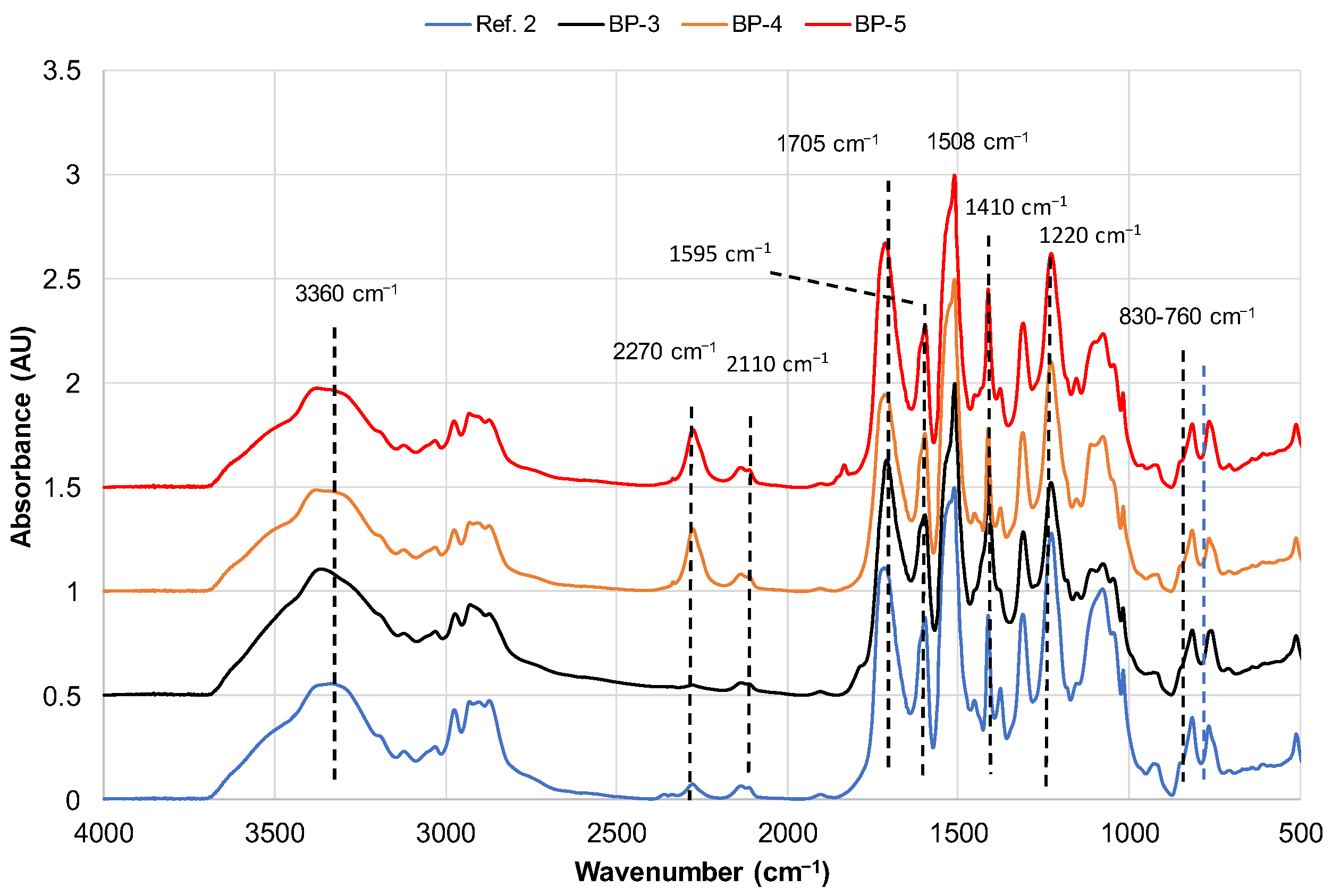




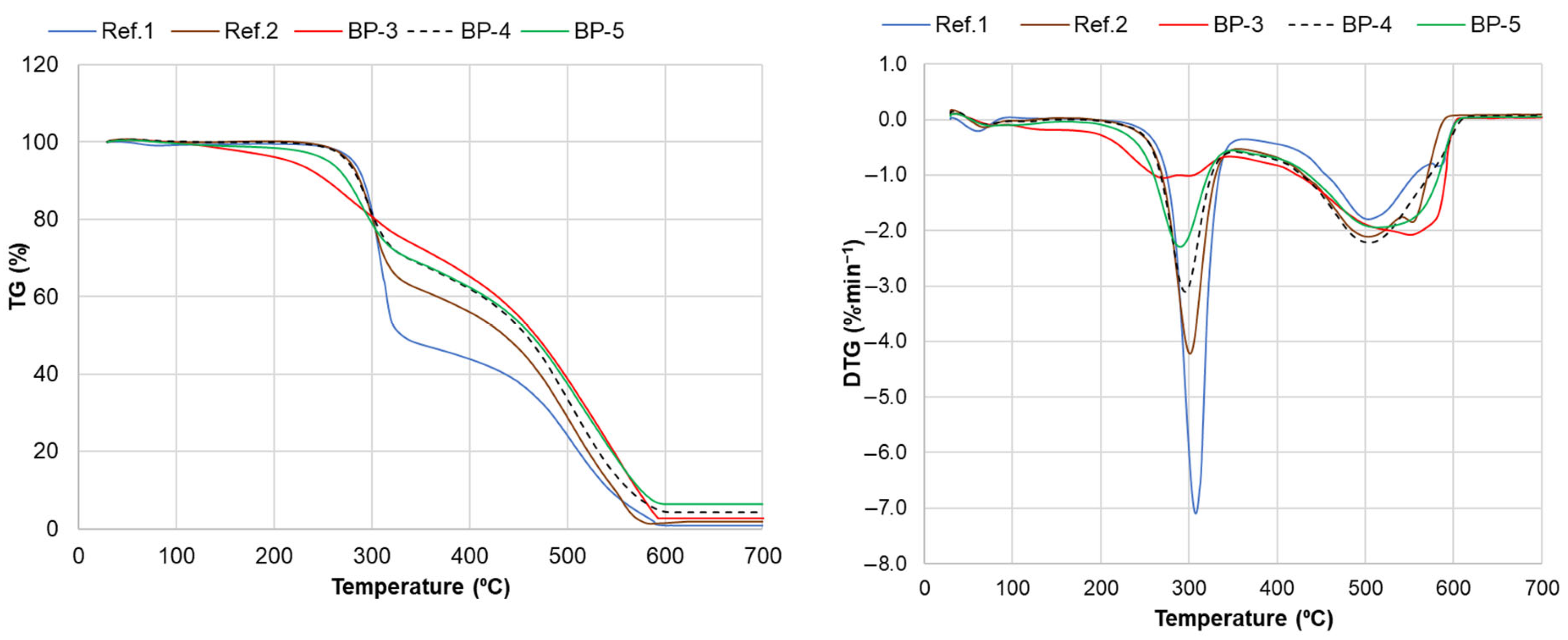

| Sample | Elemental Composition % | Ash Content (%) | Fixed Carbon Content 2 (%) | |||
|---|---|---|---|---|---|---|
| C | H | N | O 1 | |||
| Un-treated bark | 52.1 ± 0.6 | 5.98 ± 0.04 | 0.38 ± 0.04 | 38.4 | 3.1 ± 0.2 | 27.2 ± 0.5 |
| Extractives | 54.5 ± 0.3 | 5.76 ± 0.03 | 0.39 ± 0.01 | 38.2 | 1.2 ± 0.1 | 42.5 ± 1.0 |
| Residual bark | 51.8 ± 0.2 | 6.05 ± 0.02 | 0.34 ± 0.01 | 39.1 | 2.70 ± 0.02 | 28.0 ± 0.3 |
| Composition 1 (%) | Characteristics of Bio-Polyol | ||||||
|---|---|---|---|---|---|---|---|
| Extractives | PC | DBU | Biomass Content 2 (%) | DBU Content 2 (%) | OHV, mgKOH∙g−1 | Viscosity at 25 °C (mPa∙s) | H2O by K.F., % |
| 17.5 | 79.6 | 3.0 | 26.5 | 4.4 | 464 | 1050 | 0.09 |
| Position | Formulation | ||||||
|---|---|---|---|---|---|---|---|
| Ref. 1 | Ref. 2 | BP-1 | BP-2 | BP-3 | BP-4 | BP-5 | |
| Composition (pbW): Lupranol 3300 Lupranol 3422 Oxypropylated extractives Liquified extractives | 100 - - | 70 30 - - | - 30 70 - | - 30 - 70 | - - 100 - | - - - 100 | - - - 50 50 |
| Water | 0.50 | 0.50 | 0.50 | 0.45 | 0.50 | 0.35 | 0.45 |
| Catalyst Polycat 5 | 0.7 | 0.7 | - | 0.7 | - | - | - |
| Surfactant, Niax Silicone | 1.5 | 1.5 | 1.5 | 1.5 | 1.5 | 1.5 | 1.5 |
| Blowing agent Opteon TM 1100 | 20 | 20 | 20 | 20 | 20 | 20 | 20 |
| pMDI | 119.5 | 126.9 | 139.1 | 151.4 | 136.9 | 157.5 | 147.2 |
| B/A ratio 1 | 0.97 | 1.03 | 1.14 | 1.23 | 1.12 | 1.28 | 1.21 |
| Bark biomass content in PUR (%) 2 | - | - | 7.7 | 5.8 | 11.1 | 8.1 | 9.5 |
| Position | Formulation | ||
|---|---|---|---|
| Ref. 2/F | BP-3/F | BP-5/F | |
| Composition (pbW): Lupranol 3300 Lupranol 3422 Oxypropylated extract Liquified extract | 70 30 - - | - - 100 - | - - - 50 50 |
| Filler | 10–40 | 10–40 | 10–40 |
| Water | 0.50 | 0.50 | 0.45 |
| Catalyst Polycat 5 | 0.7 | - | - |
| Surfactant, Niax Silicone | 1.5 | 1.5 | 1.5 |
| Blowing agent Opteon TM 1100 | 20 | 20 | 20 |
| pMDI | 126.9 | 136.9 | 147.2 |
| B/A ratio 1 | 1.03 | 1.12 | 1.21 |
| Biomass content in PUR (%) 2 | 4.2–13.8 | 14.9–24.2 | 13.1–22.1 |
| Sample | T5% (°C) a | (%∙min −1) b | Tmax (°C) c | T50%(%∙min−1) d | Δm500 °C (%) e |
|---|---|---|---|---|---|
| Ref. 1 | 282 ± 5 | 7.1 ± 0.4 | 308 ± 8 | 350 ± 10 | 24.2 ± 1.0 |
| Ref. 2 | 272 ± 6 | 4.2 ± 0.2 | 303 ± 2 | 436 ± 9 | 32.1 ± 1.2 |
| BP-3 | 217 ± 5 | 1.1 ± 0.06 | 285 ± 3 | 468 ± 10 | 38.8 ± 2.0 |
| BP-3/F | 224 ± 2 | 2.3 ± 0.1 | 280 ± 5 | 414 ± 12 | 21.1 ± 1.6 |
| BP-4 | 275 ± 3 | 3.1 ± 0.2 | 295 ± 6 | 458 ± 8 | 33.7 ± 2.5 |
| BP-5 | 256 ± 4 | 2.3 ± 0.1 | 291 ± 4 | 463 ± 10 | 37.5 ± 2.8 |
| BP-5/F | 251 ± 5 | 2.4 ± 0.1 | 288 ± 3 | 432 ± 7 | 23.9 ± 1.1 |
| Extracted bark (filler) | 233 ± 6 | 2.5 ± 0.2 | 300 ± 2 | 357 ± 10 | 6.0 ± 1.0 |
Disclaimer/Publisher’s Note: The statements, opinions and data contained in all publications are solely those of the individual author(s) and contributor(s) and not of MDPI and/or the editor(s). MDPI and/or the editor(s) disclaim responsibility for any injury to people or property resulting from any ideas, methods, instructions or products referred to in the content. |
© 2024 by the authors. Licensee MDPI, Basel, Switzerland. This article is an open access article distributed under the terms and conditions of the Creative Commons Attribution (CC BY) license (https://creativecommons.org/licenses/by/4.0/).
Share and Cite
Arshanitsa, A.; Pals, M.; Vevere, L.; Jashina, L.; Bikovens, O. The Complex Valorization of Black Alder Bark Biomass in Compositions of Rigid Polyurethane Foam. Materials 2025, 18, 50. https://doi.org/10.3390/ma18010050
Arshanitsa A, Pals M, Vevere L, Jashina L, Bikovens O. The Complex Valorization of Black Alder Bark Biomass in Compositions of Rigid Polyurethane Foam. Materials. 2025; 18(1):50. https://doi.org/10.3390/ma18010050
Chicago/Turabian StyleArshanitsa, Alexandr, Matiss Pals, Laima Vevere, Lilija Jashina, and Oskars Bikovens. 2025. "The Complex Valorization of Black Alder Bark Biomass in Compositions of Rigid Polyurethane Foam" Materials 18, no. 1: 50. https://doi.org/10.3390/ma18010050
APA StyleArshanitsa, A., Pals, M., Vevere, L., Jashina, L., & Bikovens, O. (2025). The Complex Valorization of Black Alder Bark Biomass in Compositions of Rigid Polyurethane Foam. Materials, 18(1), 50. https://doi.org/10.3390/ma18010050








